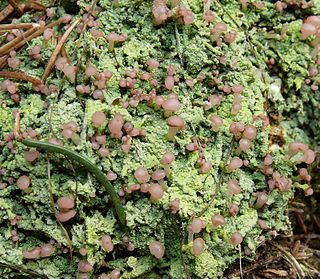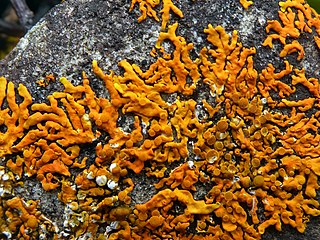
Parmelia is a genus of medium to large foliose lichens. It has a global distribution, extending from the Arctic to the Antarctic continent but concentrated in temperate regions. There are about 40 species in Parmelia. In recent decades, the once large genus Parmelia has been divided into a number of smaller genera according to thallus morphology and phylogenetic relatedness.

The Peltigeraceae are a family of lichens in the order Peltigerales. The Peltigeraceae, which contains 15 genera and about 600 species, has recently (2018) been emended to include the families Lobariaceae and Nephromataceae. Many Peltigeraceae species have large and conspicuous, leathery thalli. They largely occur in cool-temperate to tropical montane climates. Tripartite thalli involving fungus, green algae and cyanobacteria are common in this family.

Pycnothelia is a genus of lichen-forming fungi in the family Cladoniaceae. Pycnothelia was promoted to generic status by French naturalist Léon Jean Marie Dufour in 1821; it was originally circumscribed by Erik Acharius in 1799 as a section of the now-defunct genus Cenomyce.

Physconia is a genus of lichen-forming fungi in the family Physciaceae. It has about 25 species. The genus was circumscribed by Czech lichenologist Josef Poelt in 1965, with Physconia pulverulenta assigned as the type species.

Xanthoria is a genus of lichenized fungi in the family Teloschistaceae. Common names include orange lichen, orange wall lichen, and sunburst lichen. They can be identified by their characteristic squamulose morphology with distinctive "fairy cups".

Chiodecton is a genus of lichens in the family Roccellaceae. The genus was circumscribed by lichenologist Erik Acharius in 1814, with Chiodecton sphaerale assigned as the type species.

Endocarpon is a genus of saxicolous (rock-dwelling), crustose lichens in the family Verrucariaceae. The genus was circumscribed by German bryologist Johann Hedwig in 1789.

Catapyrenium is a genus of lichens in the family Verrucariaceae. The genus was circumscribed by German botanist Julius von Flotow in 1850.

Thelidium is a genus of lichen-forming fungi in the family Verrucariaceae. The genus was circumscribed in 1855 by Italian lichenologist Abramo Bartolommeo Massalongo, who assigned Thelidium amylaceum as the type species.
Everniopsis is a fungal genus in the family Parmeliaceae. It consists of a single species, the bark-dwelling lichen Everniopsis trulla, which occurs in Africa and South America.
Stenocybe is a genus of fungi in the family Mycocaliciaceae. It has 14 species.

Gyalecta is a genus of fungi in the family Gyalectaceae that contains 50 species. Gyalecta was circumscribed by lichenologist Erik Acharius in 1808.

Hypocenomyce is a genus of lichen-forming fungi in the family Ophioparmaceae. Species in the genus grow on bark and on wood, especially on burned tree stumps and trunks in coniferous forest. Hypocenomyce lichens are widely distributed in the northern hemisphere.

Baeomyces is a genus of lichenized fungi in the family Baeomycetaceae. Members of Baeomyces are commonly called cap lichens. The genus was circumscribed by German mycologist Christiaan Hendrik Persoon in 1794. Although Persoon did not designate a type species in his original description of the genus, Frederick Clements and Cornelius Lott Shear assigned Baeomyces byssoides as the type in 1931.

Loxospora is a genus of lichen-forming fungi in the family Sarrameanaceae. It has 13 species. The genus was circumscribed by Italian lichenologist Abramo Bartolommeo Massalongo in 1852, with Loxospora elatina assigned as the type species. This crustose lichen was originally named Lecanora elatina by Erik Acharius in 1810.

Bathelium is a genus of lichen-forming fungi in the family Trypetheliaceae. The genus was circumscribed in 1803 by Swedish lichenologist Erik Acharius, with Bathelium mastoideum assigned as the type species.

Dufourea is a genus of mostly foliose lichen species in the subfamily Xanthorioideae of the family Teloschistaceae. Species in the genus are mostly found in the Southern Hemisphere.

Solorina crocea, commonly known as the orange chocolate chip lichen, is a species of terricolous (ground-dwelling) and foliose (leafy) lichen in the family Peltigeraceae. The lichen, which was first formally described by Carl Linnaeus in 1753, has an arctic–alpine and circumpolar distribution and occurs in Asia, Europe, North America, and New Zealand. It generally grows on the bare ground in sandy soils, often in moist soil near snow patches or seepage areas. Although several forms and varieties of the lichen have been proposed in its history, these are not considered to have any independent taxonomic significance.

Crocodia is a genus of foliose lichens in the family Peltigeraceae. It has eight species. The genus has a cosmopolitan distribution, although most species occur in temperate and tropical regions of the Southern Hemisphere. The main characteristics of the genus that separate it from its parent genus, Pseudocyphellaria, include a yellow medulla and yellow pseudocyphellae on the lower thallus surface.

Nigrovothelium is a genus of lichen-forming fungi in the family Trypetheliaceae. It has three species. The genus was circumscribed in 2016 by lichenologists Robert Lücking, Matthew Nelsen, and André Aptroot, to contain species formerly in the Trypethelium tropicum species group. The type species, Nigrovothelium tropicum, was originally described by Erik Acharius in 1810, as a species of Verrucaria.


















